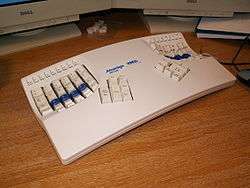Kinesis (keyboard)
The Kinesis line of ergonomic computer keyboards is an alternative to the traditional keyboard design. Most widely known among these are the contoured Advantage line, which feature recessed keys in two bucket-like hollows which allow the fingers to reach keys with less effort as well as a central array of modifiers such as enter, alt, backspace, control, etc. where they can be pressed with the thumbs. All Kinesis keyboards (except the Essential) support the capability to re-map individual keys.[1][2] Recent models also come with the ability to switch between the Dvorak layout with the press of a special key combination, though keycaps printed with dual-legend QWERTY/Dvorak letters are included only on specific models. Moreover, the keys are laid out in perfect vertical rows to avoid the need for lateral movements during typing.

The top row of keys, including the escape key and function keys, are small soft-touch keys with membrane dome switches. The remaining keys are standard size and each has its own Cherry MX brown key switch, providing a tactile feel, but no click. A piezo buzzer provides optional key click.
Uses
The Kinesis line of keyboards are marketed to those who type throughout the work-day, and thus perceive a higher risk for such injuries as RSI. The Kinesis was first used among computer programmers, who continue to be the primary market for the devices.

See also
- Maltron keyboard
- Physical ergonomics
- Dvorak keyboard layout